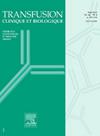Trends in new hepatitis C virus infections among repeat blood donors – Georgia, 2017–2023
IF 1.2
4区 医学
Q4 HEMATOLOGY
引用次数: 0
Abstract
Background and objectives
Blood donor cohorts are an underappreciated resource for surveillance and public health programming for infectious diseases. The incidence of hepatitis C virus (HCV) infection was evaluated in repeat blood donors in Georgia.
Materials and methods
Using data from the national hepatitis C screening registry, we calculated overall hepatitis C incidence for 2017–2023 and annual incidence during 2017–2022 among adults who donated blood at least twice and had a nonreactive HCV antibody (anti-HCV) test result upon first screening and a subsequent anti-HCV test conducted in any location. Rates of anti-HCV seroconversion and current infection were calculated by year, sex, age group, and location of last HCV screening and expressed per 100,000 person-years (PY).
Results
Of 101,443 blood donors with ≥ 2 anti-HCV results,775 (0.8%) seroconverted to anti-HCV reactive, of whom 403 (52.0%) had current infection. Incidence of anti-HCV seroconversion decreased from 408 per 100,000 PY in 2017 to 218 per 100,000 PY in 2022 and incidence of infection decreased from 172 per 100,000 PY in 2017 to 118 per 100,000 PY in 2022. Males, persons aged 18–39 years, and people last tested for HCV in prisons had the highest incidence rates for anti-HCV seroconversion and HCV infection, while persons last screened in blood banks and during antenatal care had the lowest.
Conclusion
Despite the observed decline, incidence of HCV infection among repeat blood donors remains high in specific subgroups. Hepatitis C prevention, screening and treatment interventions need to particularly focus on incarcerated populations and young adults in Georgia.
2017-2023 年重复献血者中新感染丙型肝炎病毒的趋势 - 佐治亚州。
背景和目标:献血者队列是一种未得到充分重视的传染病监测和公共卫生计划资源。我们对格鲁吉亚重复献血者的丙型肝炎病毒(HCV)感染率进行了评估:利用全国丙型肝炎筛查登记处的数据,我们计算了 2017-2023 年期间丙型肝炎的总体发病率,以及 2017-2022 年期间至少献血两次、首次筛查时丙型肝炎病毒抗体(抗-HCV)检测结果为非反应性以及随后在任何地点进行抗-HCV 检测的成年人的年度发病率。抗-HCV血清转换率和当前感染率按年份、性别、年龄组和最后一次HCV筛查的地点进行计算,并以每十万人年(PY)为单位表示:在 101,443 名抗 HCV 结果≥2 次的献血者中,775 人(0.8%)血清转换为抗 HCV 反应性,其中 403 人(52.0%)目前已感染。抗-HCV血清转换发生率从2017年的每10万人中有408人降至2022年的每10万人中有218人,感染发生率从2017年的每10万人中有172人降至2022年的每10万人中有118人。男性、18-39 岁人群以及最后一次在监狱接受 HCV 检测的人群的抗 HCV 血清转换率和 HCV 感染率最高,而最后一次在血库和产前检查中接受筛查的人群的感染率最低:结论:尽管已观察到丙型肝炎病毒感染率有所下降,但在特定亚群体中,重复献血者的丙型肝炎病毒感染率仍然很高。丙型肝炎预防、筛查和治疗干预措施需要特别关注格鲁吉亚的被监禁人群和年轻成年人。
本文章由计算机程序翻译,如有差异,请以英文原文为准。
求助全文
约1分钟内获得全文
求助全文
来源期刊
CiteScore
2.50
自引率
11.80%
发文量
234
审稿时长
36 days
期刊介绍:
Transfusion Clinique et Biologique, the official journal of the French Society of Blood Transfusion (SFTS):
- an aid to training, at a European level
- the only French journal indexed in the hematology and immunology sections of Current Contents
Transfusion Clinique et Biologique spans fundamental research and everyday practice, with articles coming from both sides. Articles, reviews, case reports, letters to the editor and editorials are published in 4 editions a year, in French or in English, covering all scientific and medical aspects of transfusion: immunology, hematology, infectious diseases, genetics, molecular biology, etc. And finally, a convivial cross-disciplinary section on training and information offers practical updates.
Readership:
"Transfusers" are many and various: anesthetists, biologists, hematologists, and blood-bank, ICU and mobile emergency specialists...

 求助内容:
求助内容: 应助结果提醒方式:
应助结果提醒方式:


